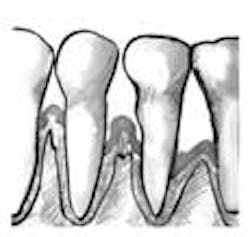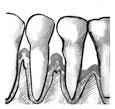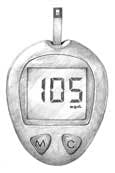Diabetes update
For many years, an association between diabetes and periodontitis has been discussed. Lately, this relationship has been suggested to be bidirectional with each disorder able to influence the other condition. A recent review looked at this relationship and found that the available data suggest that diabetes is a risk, as well as a modifying factor, for periodontitis.(1) People with diabetes are more likely to have periodontitis and with increased severity when diabetes is uncontrolled or poorly controlled. Possible mechanisms of how diabetes affects periodontitis include adipokine‐mediated inflammation, neutrophil dysfunction, uncoupling of bone and advanced glycation end‐products–receptor for advanced glycation end‐products interaction.(1) Evidence continues to accumulate to show how periodontitis can affect diabetes and complications associated with diabetes. There is some evidence indicating that periodontal therapy can result in a moderate improvement in glycemic control.(2,3) One meta-analysis suggests that periodontal treatment leads to an improvement of glycemic control in type 2 diabetic patients for at least 3 months.(4) Available evidence indicates that diabetes and periodontitis are complexly interrelated and that each condition has the capability to influence clinical features of each other.
Data from the National Health and Nutrition Examination Study (NHANES) 2009–2010 showed that the total prevalence of periodontitis in adults aged 30 years and older was 47.2% in the United States.(5) When the Centers for Disease Control and Prevention- American Academy of Periodontology case definitions were applied, the prevalence of mild, moderate and severe periodontitis was 8.7%, 30.0% and 8.5%, respectively.(1)
Several epidemiological studies have reported an association between metabolic syndrome and periodontal diseases. A systematic review investigated the existence and magnitude of this possible association.(6) The review showed strong evidence for an association between metabolic syndrome and periodontitis. The direction of the association and factors influencing it should be investigated by longitudinal and treatment studies. Periodontal diagnostic procedures should be routinely carried out in metabolic syndrome patients, according to the authors.
Conversely, for people with type 2 diabetes and chronic periodontitis, nonsurgical periodontal treatment did not result in improved glycemic control, according to a December 2013 study published in the Journal of the American Medical Association (JAMA).(7) The researchers studied whether nonsurgical periodontal therapy, compared with no therapy, reduces levels of glycated hemoglobin (HbAlc) levels in persons with type 2 diabetes and moderate to advanced chronic periodontitis. The treatment group received scaling and root planing plus an oral rinse at baseline and supportive periodontal therapy at 3 and 6 months. The control group received no treatment for 6 months. Although periodontal treatment improved clinical measures of chronic periodontitis, as we well know, the findings of this study do not support the use of nonsurgical periodontal treatment for the purpose of lowering levels of HbAlc.(8)
Along these lines, California might become the first state to require warning labels on the front of sodas and other sugary drinks under proposed legislation announced in Sacramento. Senate bill (SB1000), would require manufacturers to place warnings on beverage containers that have added sweeteners that have 75 or more calories in every 12 ounces.(9) The label would read: "STATE OF CALIFORNIA SAFETY WARNING: Drinking beverages with added sugar(s) contributes to obesity, diabetes, and tooth decay."(10) The bill is being supported by the California Medical Association, the California Center for Public Health Advocacy, the Latino Coalition for a Healthy California, and the California Black Health Network. The beverage industry feels the bill is "misleading" because it said just 6 percent of calories in the average American's diet come from soda, fruit, sports and energy drinks, compared with 11 percent in sweets and deserts.(10) Most calories are consumed in the form of fats, oils and starches in food.(10) Other groups have disputed these data, stating that sugary drinks are the largest source of added calories in American's diet in the last three decades. They also said one soda a day boosts an adult's chances of being overweight by 27 percent and a child's by 55 percent, and it can increase the risk of diabetes by 26 percent.(10)
Bottom line. Educate patients about the link between a healthy mouth and healthy body. Prevention and periodontal therapy improve the oral condition, and may improve systemic conditions, as well.References 1. Chee B, Park B, and Bartold M. Periodontitis and type II diabetes: a two‐way relationship. International Journal of Evidence-Based Healthcare: December 2013 - Volume 11 - Issue 4 - p 317–329. 2. Paraskevas S, Huizinga JD, Loos BG. A systematic review and meta‐analyses on C‐reactive protein in relation to periodontitis. J Clin Periodontol, 2008; 35: 277–290. 3. Holman RR, Paul SK, Bethel MA, Matthews DR, Neil HA. 10‐year follow‐up of intensive glucose control in type 2 diabetes. N Engl J Med, 2008; 359: 1577–1589. 4. Teeuw WJ, Gerdes VEA, and Loos BG. Effect of Periodontal Treatment on Glycemic Control of Diabetic Patients- A systematic review and meta-analysis. Diabetes Care. February 2010 vol. 33 no. 2 421-427. 5. Eke PI, Dye BA, Wei L, Thornton‐Evans GO, Genco RJ. Prevalence of periodontitis in adults in the United States: 2009 and 2010. J Dent Res, 2012; 91: 914–920. 6. Nibali L, Tatarakis N, Needleman I, Tu YK, D'Aiuto F, Rizzo M, Donos N. Clinical review: Association between metabolic syndrome and periodontitis: a systematic review and meta-analysis. J Clin Endocrinol Metab. 2013 Mar;98(3):913-20. doi: 10.1210/jc.2012-3552. Epub 2013 Feb 5. 7. Engebretson SP, Hyman LG, Michalowicz BS, Schoenfeld ER, Gelato MC, Hou W, Seaquist ER, Reddy MS, Lewis CE, Oates TW, Tripathy D, Katancik JA, Orlander PR, Paquette DW, Hanson NQ, and Tsai MY. The Effect of Nonsurgical Periodontal Therapy on Hemoglobin A1cLevels in Persons With Type 2 Diabetes and Chronic Periodontitis. JAMA, 2013; 310 (23): 2523 8. The JAMA Network Journals. "Nonsurgical treatment of periodontitis for diabetics does not improve glycemic control." ScienceDaily. ScienceDaily, 17 December 2013. www.sciencedaily.com/releases/2013/12/131217170958.htm. 9. http://legiscan.com/CA/research/SB1000/2013. 10. http://news.yahoo.com/california-bill-seeks-warnings-sugary-drinks-222258256.html.






